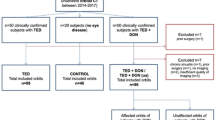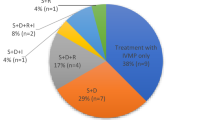Abstract
Purpose
Addressing Dysthyroid Optic Neuropathy (DON) is crucial due to its debilitating impact in thyroid eye disease (TED). Prompt treatment can preserve vision. Despite lacking definitive diagnostic criteria, computed tomography’s (CT) parameters are commonly used for diagnosis. However, these parameters exist without consensus on their diagnostic performance.
Design
Systematic review and meta-analysis.
Methods
We conducted a meta-analysis of studies assessing orbital CT diagnostic performance for DON in adults with TED. We searched various databases including Medline, PubMed, Scopus, and EMBASE, and others electronic databases, until July 2023. Evaluated CT parameters includes Barrett index (BI), fat prolapse via superior-orbital-fissure (SOF), superior-ophthalmic-vein-dilatation (SOVD), and the Nugent score. Diagnostic Test Accuracy analysis (DTA) was performed using R.
Results
A total of 9 articles with documented target parameters, collectively analysed 212 orbits with DON. Nugent score exhibited highest diagnostic ability with a log diagnostic odd ratio (logDOR) of 2.64 (95% CI, 2.02, 3.25). Another significant DON indicator was a BI ≥ 50%, with a logDOR of 1.97 (95% CI, 1.17; 2.77). Conversely, fat prolapse via SOF and SOVD proved less sensitive, with a logDOR of 1.42 and 1.09 respectively. Regarding the SROC curve, Nugent score and the BI have the greatest AUC. Variations in study locale, participant demographics, and measurement methods accounted for heterogeneity in meta-analysis.
Conclusions
Nugent score and a BI ≥ 50% prove to be significant diagnostic parameters for DON, distinguishing them from fat prolapse via SOF and SOVD. Prioritizing these parameters can lead to prompt treatment and thus enhanced visual outcomes.
PROSPERO Registration number
CRD42023446376.
This is a preview of subscription content, access via your institution
Access options
Subscribe to this journal
Receive 18 print issues and online access
$259.00 per year
only $14.39 per issue
Buy this article
- Purchase on Springer Link
- Instant access to full article PDF
Prices may be subject to local taxes which are calculated during checkout

Similar content being viewed by others
Data availability
The data that support the findings of this study are available from the corresponding author upon reasonable request.
References
Neigel JM, Rootman J, Belkin RI, Nugent RA, Drance SM, Beattie CW, et al. Dysthyroid optic neuropathy. The crowded orbital apex syndrome. Ophthalmology. 1988;95:1515–21.
Bartley GB. The differential diagnosis and classification of eyelid retraction. Ophthalmology. 1996;103:168–76.
Kazim M, Trokel S, Moore S. Treatment of acute Graves orbitopathy. Ophthalmology. 1991;98:1443–8.
Dayan CM, Dayan MR. Dysthyroid optic neuropathy: a clinical diagnosis or a definable entity? Br J Ophthalmol. 2007;91:409–10.
Barrett L, Glatt HJ, Burde RM, Gado MH. Optic nerve dysfunction in thyroid eye disease: CT. Radiology. 1988;167:503–7.
Giaconi JA, Kazim M, Rho T, Pfaff C. CT scan evidence of dysthyroid optic neuropathy. Ophthalmic Plast Reconstr Surg. 2002;18:177–82.
Nugent RA, Belkin RI, Neigel JM, Rootman J, Robertson WD, Spinelli J, et al. Graves orbitopathy: correlation of CT and clinical findings. Radiology. 1990;177:675–82.
Birchall D, Goodall KL, Noble JL, Jackson A. Graves ophthalmopathy: intracranial fat prolapse on CT images as an indicator of optic nerve compression. Radiology. 1996;200:123–7.
Lima Bda R, Perry JD. Superior ophthalmic vein enlargement and increased muscle index in dysthyroid optic neuropathy. Ophthalmic Plast Reconstr Surg. 2013;29:147–9.
Yang B, Mallett S, Takwoingi Y, Davenport CF, Hyde CJ, Whiting PF, et al. QUADAS-C: A Tool for Assessing Risk of Bias in Comparative Diagnostic Accuracy Studies. Ann Intern Med. 2021;174:1592–9.
Reitsma JB, Glas AS, Rutjes AW, Scholten RJ, Bossuyt PM, Zwinderman AH. Bivariate analysis of sensitivity and specificity produces informative summary measures in diagnostic reviews. J Clin Epidemiol. 2005;58:982–90.
Monteiro ML, Gonçalves AC, Silva CT, Moura JP, Ribeiro CS, Gebrim EM. Diagnostic ability of Barrett’s index to detect dysthyroid optic neuropathy using multidetector computed tomography. Clin (Sao Paulo). 2008;63:301–6.
Gonçalves AC, Silva LN, Gebrim EM, Monteiro ML. Quantification of orbital apex crowding for screening of dysthyroid optic neuropathy using multidetector CT. AJNR Am J Neuroradiol. 2012;33:1602–7.
Kemchoknatee P, Chenkhumwongse A, Dheeradilok T, Srisombut T. Diagnostic Ability of Barrett’s Index and Presence of Intracranial Fat Prolapse in Dysthyroid Optic Neuropathy. Clin Ophthalmol. 2022;16:2569–78.
Yu B, Gong C, Ji YF, Xia Y, Tu YH, Wu WC. Predictive parameters on CT scan for dysthyroid optic neuropathy. Int J Ophthalmol. 2020;13:1266–71.
Cheng S, Ming Y, Hu M, Zhang Y, Jiang F, Wang X, et al. Risk prediction of dysthyroid optic neuropathy based on CT imaging features combined the bony orbit with the soft tissue structures. Front Med (Lausanne). 2022;9:936819.
Gonçalves AC, Silva LN, Gebrim EM, Matayoshi S, Monteiro ML. Predicting dysthyroid optic neuropathy using computed tomography volumetric analyses of orbital structures. Clin (Sao Paulo). 2012;67:891–6.
Weis E, Heran MK, Jhamb A, Chan AK, Chiu JP, Hurley MC, et al. Clinical and soft-tissue computed tomographic predictors of dysthyroid optic neuropathy: refinement of the constellation of findings at presentation. Arch Ophthalmol. 2011;129:1332–6.
McKeag D, Lane C, Lazarus JH, Baldeschi L, Boboridis K, Dickinson AJ, et al. Clinical features of dysthyroid optic neuropathy: a European Group on Graves’ Orbitopathy (EUGOGO) survey. Br J Ophthalmol. 2007;91:455–8.
Dolman PJ. Dysthyroid optic neuropathy: evaluation and management. J Endocrinol Invest. 2021;44:421–9.
Murakami Y, Kanamoto T, Tuboi T, Maeda T, Inoue Y. Evaluation of extraocular muscle enlargement in dysthyroid ophthalmopathy. Jpn J Ophthalmol. 2001;45:622–7.
Lu C, Lai CL, Yang CM, Liao KC, Kao CS, Chang TC, et al. The relationship between obesity-related factors and graves’ orbitopathy: a pilot study. Med (Kaunas). 2022;58:1748.
Patel VK, Padnick-Silver L, D’Souza S, Bhattacharya RK, Francis-Sedlak M, Holt RJ. Characteristics of diabetic and nondiabetic patients with thyroid eye disease in the United States: a claims-based analysis. Endocr Pr. 2022;28:159–64.
Funding
No funding was received for this work.
Author information
Authors and Affiliations
Contributions
T.S.: conceptualization, senior reviewer, data curation, formal analysis, investigation, methodology, visualization, draft preparation of original manuscript, writing —review & editing., N.A.: data curation, writing & review., N.V.: data curation, writing & review., A.K.: data curation, writing & review., P.K.: conceptualization, senior reviewer, formal analysis, visualization, supervision, writing & review.
Corresponding author
Ethics declarations
Competing interests
The authors declare no competing interests.
Additional information
Publisher’s note Springer Nature remains neutral with regard to jurisdictional claims in published maps and institutional affiliations.
Supplementary information
Rights and permissions
Springer Nature or its licensor (e.g. a society or other partner) holds exclusive rights to this article under a publishing agreement with the author(s) or other rightsholder(s); author self-archiving of the accepted manuscript version of this article is solely governed by the terms of such publishing agreement and applicable law.
About this article
Cite this article
Srisombut, T., Arjkongharn, N., Vongsa, N. et al. Orbital CT scan parameters in dysthyroid optic neuropathy: a systematic review and meta-analysis. Eye (2024). https://doi.org/10.1038/s41433-024-03011-6
Received:
Revised:
Accepted:
Published:
DOI: https://doi.org/10.1038/s41433-024-03011-6



